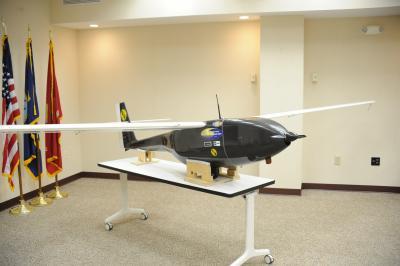Nearly undetectable from the ground, unmanned aerial vehicles (UAVs) are widely used by the military to scan terrain for possible threats and intelligence. Now, fuel cell powered UAVs are taking flight as an Office of Naval Research (ONR)-sponsored program to help tactical decision-makers gather critical information more efficiently… and more quietly.
Piloted remotely or autonomously, UAVs have long provided extra "eyes in the sky" especially for missions that are too dangerous for manned aircraft. This latest technology is showcased by Ion Tiger, a UAV research program at the Naval Research Laboratory (NRL) that merges two separate efforts — UAV technology and fuel cell systems.
In particular, the Ion Tiger UAV tests a hydrogen-powered fuel cell design, which can travel farther and carry heavier payloads than earlier battery-powered designs. Ion Tiger employs stealthy characteristics due to its small size, reduced noise, low heat signature and zero emissions.
"Pursuing energy efficiency and energy independence are core to ONR's Power and Energy Focus Area," said Rear Admiral Nevin Carr, Chief of Naval Research. "ONR's investments in alternative energy sources, like fuel cell research, have application to the Navy and Marine Corps mission in future UAVs and vehicles. These investments also contribute directly to solving some of the same technology challenges faced at the national level."
Fuel cells create an electrical current when they convert hydrogen and oxygen into water and are pollution-free. A fuel cell propulsion system can also deliver potentially twice the efficiency of an internal combustion engine — while running more quietly and with greater endurance.
"In this size range, we are hopefully able to conduct very productive surveillance missions at low cost with a relatively small vehicle, and a high-quality electric payload," says NRL Principal Investigator Dr. Karen Swider-Lyons.
This spring, Ion Tiger's flight trial is expected to exceed the duration of previous flights seven-fold.

This photo shows the Ion Tiger.
(Photo Credit: US Naval Research Laboratory)
"This will really be a 'first of its kind' demonstration for a fuel cell system in a UAV application for a 24-hour endurance flight, with a 5 pound payload," says ONR Program Manager Dr. Michele Anderson. "That's something nobody can do right now."
In 2005, NRL backed initial research in fuel cell technologies for UAVs. Today, says Swider-Lyons, it's paying off with a few lessons learned from the automotive industry.
"With UAVs, we are dealing with relatively small fuel cells of 500 watts," she explains. "It is hard to get custom, high-quality fuel cell membranes built just for this program. So we are riding along with this push for technology from the automotive industry."
"What's different with fuel cell cars is that developers are focused on volume…so they want everything very compact," adds Swider-Lyons. "Our first issue is weight, our second issue is weight and our third issue is weight!"
Besides delivering energy savings and increased power potential, fuel cell technology spans the operational spectrum from ground vehicles to UAVs, to man-portable power generation for Marine expeditionary missions to meeting power needs afloat. In fact, it's technology that Marines at Camp Pendleton are using today to power their General Motors fuel cell vehicles.
Across the board, the Navy and Marine Corps are seeking more efficient sources of energy. ONR has been researching and testing power and energy technology for decades. Often the improvements to power generation and fuel efficiency for ships, aircraft, vehicles and installations yield a direct benefit to the public.
"ONR has been a visionary in terms of providing support for this program," says Swider-Lyons.


